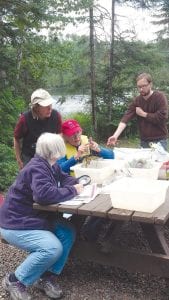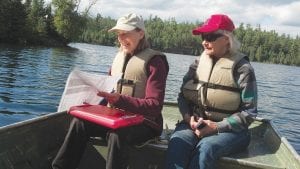Beautiful weather, a boat ride, clean water and an educational experience were part of two workshops held by Cook County Soil and Water Conservation District, sponsored by Clean Water and Land Legacy Amendment. Mary Blinkendorf from the University of Minnesota Extension instructed both workshops, Healthy Shorelands and Aquatic Vegetation. Each workshop began with sharing information inside and then moved to hands-on learning outdoors. Participants walked away with new knowledge and understanding of our lakes and shorelands, as well as reference books to continue studies.
The Healthy Shorelands workshop explored why natural vegetation and leaving the landscape as natural is best for the land and the water quality. Shoreland buffers help to slow runoff and aids in filtering excess nutrients and sediment that might otherwise enter into the lake. Buffers also help in reducing erosion along the shoreland.

On Thursday, August 28, participants in a workshop on Aquatic Vegetation took a close up look at various types of water plants.
After a discussion on the benefits of vegetation on a shoreland, the group visited a site that has been eroded over time from both humans and nature. Knowledge from the inside portion of the class was then applied to the site visit to create a plan for the property owners. Following the site visit, participants went along the shoreland in a boat to discuss why some shorelands were healthy and others were not for a lake ecosystem.
Diving deeper into the lake ecosystem, the next workshop was all about aquatic vegetation. The basics of aquatic vegetation identification, different zones in which water plants live, why it is important to a lake ecosystem (providing oxygen, habitat, and food) and what is native and what is invasive were the components of the indoor class.
After the basics, participants headed out to East Bearskin Lake to do some hands-on learning. The group boarded a pontoon boat and collected at the first site. The motor wouldn’t start so the group paddled across the lake, really exploring vegetation. With a little assistance, things were up and going again, collecting aquatic vegetation. After samples were taken at a few sites, it was back to land to identify what was found.
We could not have asked for a better day to learn about one small part of a larger watershed.



Loading Comments